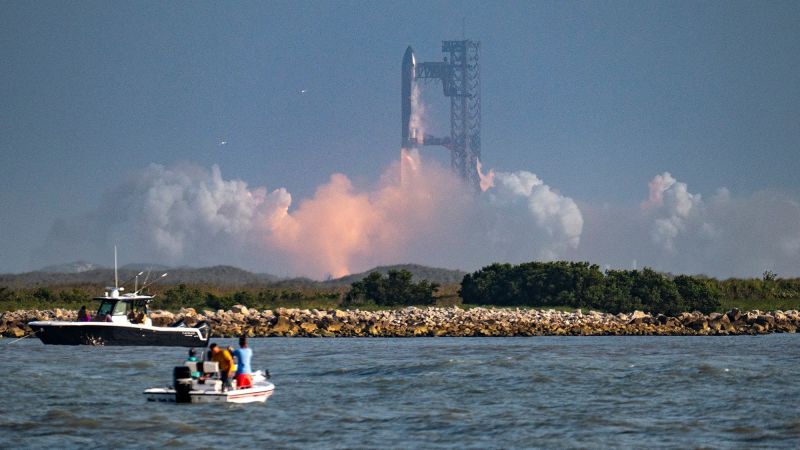The next window, during which the travel time to Mars is cut down from over a year to just six to nine months, is coming up in late 2026. Musk’s road map suggests SpaceX hopes to send up to five uncrewed Starship vehicles loaded with cargo to Mars during that time. But there are several major concerns that SpaceX will need to address before its first cargo ship sets out for the red planet, and Wednesday’s explosion — Starship’s fourth so far this year — may be evidence of that.
Anticipated upgrade for Starship
Musk spoke to the feasibility of reaching Mars in 2026 during that May speech, saying that he imagined there was only a “50/50 chance” SpaceX could get a Starship spacecraft to Mars next year.
Before the 2026 Mars transfer window opens, SpaceX plans to debut another upgraded version of the Starship spacecraft and Super Heavy rocket booster — which together make up the most powerful launch system ever constructed.
On the new Starship system, both the first-stage booster and upper-stage ship will be slightly larger and together will be able to carry 661,387 pounds (300 metric tons) of propellant.
It’s a substantial upgrade similar to the one SpaceX debuted earlier this year, Starship Version 2, which added 25% more propellant capacity compared with earlier test flight models.
And SpaceX has struggled to get Version 2 to perform as expected: The first two test flights, carried out in January and March, each failed minutes after takeoff, raining debris near populated islands east of Florida.
The last test flight in May made it farther into flight, but the Starship spacecraft lost control before reentry, leading to a nail-biting, uncontrolled descent into the Indian Ocean.
And Wednesday’s explosion during a routine ground test raises even more concerns about how long it will take SpaceX to fine-tune Starship’s design and guarantee it can transport cargo or humans safely. The company hasn’t revealed how much of a setback it might be for the vehicle or its launch facilities.
Preliminary data suggested the explosion was caused by a gas tank that exploded, Musk said in a social media post. The tank “failed below its proof pressure,” he said, meaning that prior stress tests and the known properties of the tank suggested it should have survived the scenario. It’s potentially a unique problem that has never been observed before.
During his May 29 speech, Musk emphasized that introducing even more upgrades and further stretching Starship’s size is crucial to long-term success.
“It takes three major iterations of any major new technology to have it really work well,” Musk told employees during his Starship update.
An unprecedented challenge
Musk has said he hopes the updated Starship will make its flight debut by the end of the year.
But even if the new version pulls off a pristine test flight along the same suborbital route where SpaceX has carried out previous Starship test missions, it won’t guarantee the vehicle is ready for an interplanetary excursion.
That’s because, even with added fuel capacity, Starship must be topped off with more propellant after it reaches space to make the long trip to Mars.
SpaceX plans to do this by launching a series of tankers, or Starship vehicles designed to carry batches of fuel and oxidizer. Those tankers would rendezvous with the Starship while it idles in Earth’s orbit, transferring thousands of pounds of propellant and delivering the fuel the vehicle needs to continue its journey deeper into the solar system.
Notably, transferring fuel between two vehicles in space has never been done before.
“We’ve never done that. Nobody’s done that — transferring fuel from one spacecraft to another in orbit autonomously,” said Bruce Jakosky, a professor emeritus of geological sciences at the University of Colorado Boulder’s Laboratory for Atmospheric and Space Physics.
“That’s difficult,” Jakosky added, especially considering the Starship vehicle runs on cryogenic fuels — essentially oxygen and methane that are kept at temperatures so cold they liquify. And in the microgravity environment of orbit, that fuel can float about in its tank rather than settling in one place. So, among myriad other technical difficulties, SpaceX will likely have to devise pumps or motors that can effectively funnel the fuel from one ship to another.
Currently, it’s not even clear how many tankers SpaceX would need to launch to give one Starship vehicle enough gas for a trip to Mars. (In prior estimates, NASA personnel and third-party experts projected it may take roughly one dozen Starship tankers for a moon mission.)
In his speech, Musk said that he believed in-space fuel transfer would be “technically feasible.”
SpaceX will not attempt to carry out its first tanker flight test before next year, Musk added.
Barriers to reentry
Even after SpaceX sorts out the propellant transfer problem, they’ll face another significant technological question: How will Starship survive the trip down to the surface of Mars?
Musk last month called this issue “one of the toughest problems to solve.”
“No one has ever developed a truly reusable orbital heat shield so that is extremely difficult to do,” he said. “This will be something that we’ll be working on for a few years, I think, to keep honing.”
Vehicles that need to safely land on planetary bodies while traveling at orbital speeds must have a component called a heat shield — a special coating on the vehicle’s exterior that serves as a buffer to the scorching temperatures generated by the process of entering a planet’s atmosphere.
On Mars, one crucial problem is the air: It’s almost entirely made up of carbon dioxide.
When Starship slams into Mars’ atmosphere, it will violently compress the air in front of it and create searing temperatures. And the conditions of reentry are so intense that the process literally rips electrons away from atoms and splits molecules, turning the carbon dioxide into carbon and oxygen — the latter of which may start to “oxidize” or essentially incinerate the spacecraft’s heat shield, Musk said.
Reentry on Mars will actually produce more heat–shield-destroying oxygen than the process of returning to Earth, Musk noted. Starship’s heat shield will ultimately need to be durable enough to survive both types of reentry, potentially multiple times.
The human problem
While the odds of SpaceX solving all the necessary technical quandaries in time to send a cargo-filled Starship to Mars at the end of next year are likely small, even larger problems must be solved later down the road.
If SpaceX wants to send humans to the red planet, for example, the company must figure out how to ensure Starship’s exterior can keep people safe from the deadly radiation that will shower down throughout the six-month journey. Life support systems with plenty of breathable air would need to be on board.
As Musk put it, every single human need must be accounted for. “You can’t be missing even, like, the equivalent of vitamin C,” he said.
Once a Starship vehicle reaches its destination, it would likely need to top off its fuel at a Martian depot before returning home — another feat that presents enormous technological challenges.
The idea that enough infrastructure will exist on Mars by 2029 — or 2031, as Musk has said in prior social media posts — to make such a crewed mission possible is outlandish.
Still, industry experts say SpaceX’s bold ambitions spark both excitement and skepticism.
“I am a fan of what SpaceX is trying to do. I totally subscribe to this vision of a multi-planetary society,” said Olivier de Weck, the Apollo Program Professor of Astronautics and Engineering Systems at the Massachusetts Institute of Technology. “But it’s a logistical problem first and foremost. And what’s lacking to me is the thought about the cycling, the fuel production — and the return to Earth.”
But Phil Metzger, a planetary physicist with the Florida Space Institute, emphasized that SpaceX does tend to deliver on its promises, even if it’s a few years behind schedule.
“I feel like they got unlucky on some of their (Starship test flight failures), having the types of failures they had the last three in a row,” Metzger said. “Considering their design and development philosophy, I think they’re still within the window of expected outcomes.”
But, Metzger added, “we’re reaching the point where you start to worry.”
The post A massive rocket explosion stirs up talk of setbacks. Are Musk’s Mars ambitions farther than they seem? appeared first on CNN.




